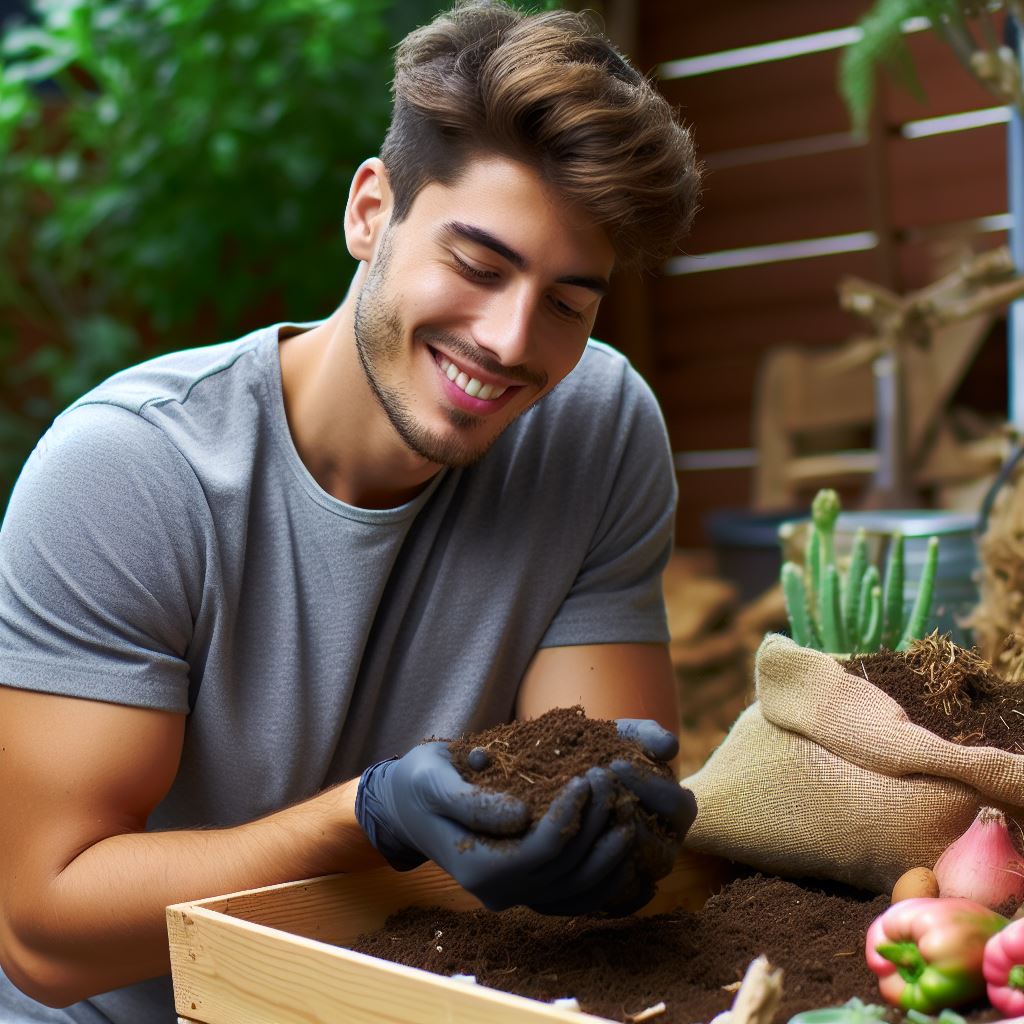Introduction
Composting is a natural process that involves the decomposition of organic waste materials, such as food scraps, yard waste, and animal manure, into nutrient-rich compost.
The resulting compost can be used as a soil amendment to improve soil structure, fertility, and overall health.
Agricultural experts and farmers alike have recognized the importance of healthy soil in achieving successful farming.
Healthy soil provides a favorable environment for plant growth, promotes nutrient availability, and enhances water retention.
By incorporating compost into the soil, the nutrients are slowly released, providing a continuous supply to plants throughout their growth cycle.
Composting not only adds nutrients to the soil but also enhances its structure.
Compost increases the soil’s ability to retain moisture, allowing for better water infiltration and reducing the risk of erosion.
The improved soil structure also facilitates root development and improves the overall aeration of the soil.
This, in turn, promotes healthier plant growth and increases crop yields.
In addition to its nutrient-enriching and soil-enhancing properties, composting also plays a significant role in reducing waste and preserving the environment.
By diverting organic waste from landfills and composting it instead, we can reduce greenhouse gas emissions and conserve landfill space.
Furthermore, composting can help to suppress plant diseases and pests, reducing the need for chemical fertilizers and pesticides.
In general, composting is crucial for improving soil health and achieving successful farming.
Through its ability to add nutrients, enhance soil structure, and reduce waste, composting provides a sustainable and environmentally friendly solution for healthier soils.
By incorporating compost into our farming practices, we can improve crop yields, conserve resources, and promote a more sustainable agricultural system.
What is Composting?
Definition and principles of composting
Composting is the process of decomposing organic materials into a nutrient-rich soil amendment.
It involves the natural breakdown of organic matter by microorganisms.
How composting works
Composting works by creating an optimal environment for microorganisms to thrive.
It requires a mixture of green (nitrogen-rich) and brown (carbon-rich) materials, moisture, oxygen, and the right temperature.
Different types of composting methods
1. Traditional composting
Traditional composting involves layering organic materials like leaves, grass clippings, and kitchen scraps in a bin or pile.
It requires regular turning to aerate and mix the materials.
2. Vermicomposting
Vermicomposting utilizes worms to break down organic matter.
A worm bin is set up, and the worms consume the materials, turning them into nutrient-rich castings.
3. Bokashi composting
Bokashi composting is an anaerobic process that uses a special mix of microorganisms to ferment organic waste in an airtight container.
This method is ideal for small spaces and can process a wide range of materials.
Composting offers numerous benefits for soil health and overall garden success.
By implementing composting practices, gardeners can improve soil structure, fertility, and nutrient availability.
Advantages of composting
Here are some key advantages of composting:
1. Enriches soil
Compost adds organic matter to the soil, improving its structure and moisture-holding capacity.
It enhances nutrient availability, promoting healthy plant growth.
2. Reduces the need for synthetic fertilizers
By incorporating compost into the soil, gardeners can reduce their reliance on synthetic fertilizers.
Compost provides a slow-release of nutrients, minimizing the risk of nutrient imbalances.
3. Enhances soil biodiversity
Compost introduces beneficial microorganisms into the soil, increasing its biological activity.
These microorganisms help break down organic matter and improve nutrient cycling.
Transform Your Agribusiness
Unlock your farm's potential with expert advice tailored to your needs. Get actionable steps that drive real results.
Get Started4. Improves soil porosity and drainage
The organic matter in compost helps improve soil porosity, allowing better air and water movement.
This leads to better root development and overall plant health.
5. Suppresses diseases and pests
Compost contains beneficial microorganisms that can help suppress harmful pathogens and pests.
It creates a healthier growing environment for plants, reducing the need for chemical interventions.
6. Reduces waste sent to landfills
Composting diverts organic waste from landfills, which helps reduce methane emissions and overall environmental impact.
It is an eco-friendly solution for managing organic waste.
In fact, composting is a natural and sustainable way to improve soil health and promote optimal plant growth.
With various composting methods available, gardeners can choose the one that best fits their needs and resources.
By incorporating compost into their gardening practices, they can create healthier soil, reduce waste, and contribute to a more sustainable future.
Read: Cooking Tips: From Farm Produce to Plate
Benefits of Composting for Soil Health
Enriches soil with essential nutrients
- Composting is an active process that transforms organic waste into nutrient-rich compost.
- The nutrient content in compost helps replenish soil, providing essential elements like nitrogen, phosphorus, and potassium.
- These nutrients are crucial for plant growth, and compost ensures they are readily available.
Improves soil structure and texture
- Compost acts as a soil amendment that enhances its overall structure and texture.
- The organic matter in compost helps bind particles together, creating better soil aggregation.
- Improved soil structure allows for better root penetration, drainage, and aeration, promoting healthier plants.
Enhances water retention capacity
- The addition of compost to soil increases its water retention capacity by improving its ability to hold moisture.
- Compost acts like a sponge, holding water for longer periods and reducing water runoff.
- This benefits plants by ensuring a steady supply of water, even during dry periods.
Suppresses diseases and pests
- Compost contains beneficial microorganisms that help suppress plant diseases and pests.
- These microorganisms outcompete harmful pathogens, creating a healthier environment for plants.
- Using compost can reduce the need for chemical pesticides, promoting natural pest control.
Reduces the need for chemical fertilizers
- Composting reduces reliance on synthetic chemical fertilizers, which can be harmful to the environment.
- The nutrient-rich compost provides a natural alternative, reducing the need for additional fertilizers.
- By using compost, gardeners can minimize their ecological impact and support sustainable gardening practices.
Overall, composting offers numerous benefits for soil health. It enriches soil with essential nutrients, improving plant growth and vitality.
Additionally, compost improves soil structure and texture, enhancing root development and overall plant health.
The increased water retention capacity of compost-amended soil ensures proper hydration for plants, even during dry spells.
Moreover, compost suppresses diseases and pests, promoting a healthier and more resilient garden ecosystem.
Lastly, by reducing the need for chemical fertilizers, composting supports environmentally friendly gardening practices.
Incorporating compost into gardening or farming routines can lead to healthier soil, thriving plants, and a more sustainable future.
Read: Farmers Markets: Your Local Food Hub

Getting Started with Composting
Choosing the right composting method
Composting is a simple and effective way to transform organic waste into nutrient-rich soil.
Before starting, consider which method suits your needs and available resources.
Determining the composting site
Select an ideal location for your compost pile, taking into account factors such as proximity to water sources, sunlight exposure, and ease of access.
Identifying suitable compostable materials
To make high-quality compost, it is crucial to include a range of organic materials that break down easily and provide essential nutrients.
- Organic kitchen waste: Include fruit and vegetable scraps, coffee grounds, tea bags, and eggshells in your compost pile. Avoid meat, dairy, and oily foods.
- Yard trimmings: Grass clippings, small branches, and pruned leaves are excellent additions to your compost pile.
- Leaves and grass clippings: Fallen leaves and grass clippings are abundant sources of carbon and nitrogen for your compost.
- Other organic materials: Utilize shredded newspaper, cardboard, sawdust, and wood chips to balance the carbon-to-nitrogen ratio in your compost.
- Avoiding certain materials: Avoid adding diseased plant material, weeds with seeds, pet waste, and synthetic products that may harm the composting process.
Layering and managing the compost pile
Achieving the ideal composition and maintaining the right conditions in your compost pile are crucial for successful decomposition.
- Proper carbon-to-nitrogen ratio: Maintain a balanced ratio of carbon-rich “brown” materials, such as leaves and cardboard, to nitrogen-rich “green” materials, like kitchen scraps.
- Moisture and aeration requirements: Ensure that your compost pile remains moist, similar to a damp sponge. Regularly turn it to allow oxygen circulation and prevent foul odors.
- Turning and maintaining the pile: Regularly mix and turn the compost to accelerate decomposition. Monitor the temperature and adjust moisture levels as needed.
Composting is a rewarding process that helps reduce waste, enrich soil, and promote healthier plants.
By following these steps, you can create nutrient-rich compost for your garden while contributing to a more sustainable environment.
Read: Sustainable Practices in Farm-to-Table
Troubleshooting Common Composting Issues
Foul odors in the compost pile
- Identify the source of the odor, which could be caused by too much moisture or anaerobic conditions.
- Add more dry materials like leaves or shredded newspaper to balance the moisture content.
- Turn the compost pile regularly to increase aeration and promote decomposition.
- Avoid adding meat, dairy products, or oily foods that can lead to unpleasant smells.
Slow decomposition process
- Ensure the proper balance of greens (nitrogen-rich) and browns (carbon-rich) materials in your compost.
- Chop or shred large organic matter into smaller pieces to speed up the decomposition process.
- Moisten the compost pile if it appears too dry, as moisture helps microbes break down materials.
- Turn the compost pile more frequently to provide oxygen and facilitate decomposition.
Pests or unwanted animals
- Keep compost pile covered with a sturdy lid or fine mesh to prevent access by rodents or larger animals.
- Avoid adding food scraps that may attract pests and opt for a compost bin with secure closures.
- If pests are already present, consider using natural deterrents like garlic spray or placing traps around the pile.
- Regularly inspect the area around the compost pile for any signs of pest activity.
Excessive heat or cold affecting composting
- In hot weather, monitor the moisture level of the compost pile and water as needed to prevent drying out.
- Turn the compost pile more frequently in hot weather to prevent overheating and aid in decomposition.
- Add insulation like straw or cardboard during cold weather to maintain appropriate temperatures for composting.
- Consider moving the compost pile to a more sheltered location if extreme temperatures persist.
With these troubleshooting tips, you can overcome common issues encountered during composting.
Remember, patience and consistency are key to achieving healthy, nutrient-rich soil through composting.
Read: Farm-to-Fork: Understanding the Chain
Using Compost in the Garden
When is compost ready to use?
Using compost in the garden can greatly improve soil health and plant growth.
Compost provides essential nutrients, improves soil structure, retains moisture, and promotes beneficial microbial activity.
However, to maximize its benefits, it is important to know when the compost is ready to use and how to incorporate it properly into the soil.
Compost is ready to use when it has decomposed completely and has a dark, crumbly texture.
Immature compost, indicated by a strong odor or recognizable organic materials, should be avoided as it can contain pathogens or weed seeds that may harm plants.
To incorporate compost into the soil, there are several methods you can choose from.
Methods of incorporating compost into the soil
Topdressing is a simple method where you spread a thin layer of compost on top of the existing soil surface.
This is especially beneficial for established plants and can help suppress weeds while adding nutrients.
Mulching, on the other hand, involves placing a thick layer of compost around plants.
This acts as a protective barrier, retaining moisture, regulating soil temperature, and preventing weed growth.
For potted plants and container gardens, mixing compost into potting soil is recommended.
This helps improve the soil structure, water-retention capacity, and nutrient availability for the plants.
The ratio of compost to potting soil may vary depending on the specific needs of the plants, but a general guideline is to use equal parts of each.
Recommended application rates
When applying compost, it is important to follow recommended application rates.
Aim for a layer of compost that is 1 to 2 inches thick on the soil surface.
Applying too much compost can lead to waterlogged soil, nutrient imbalances, or the suppression of plant roots.
If in doubt, it is always better to start with a conservative amount and gradually increase as needed.
While compost is beneficial for soil health, it should not be solely relied upon for fertilization.
Compost provides a slow-release source of nutrients, but additional organic or synthetic fertilizers may be necessary to meet the specific needs of certain plants.
It is important to monitor the soil’s nutrient levels and adjust the fertilization accordingly.
Lastly, when using compost, make sure to avoid placing it too close to plant stems. This can create a favorable environment for rot or disease development.
Maintain a gap of a few inches between the compost and the stems to promote healthy plant growth and minimize the risk of infections.
Showcase Your Farming Business
Publish your professional farming services profile on our blog for a one-time fee of $200 and reach a dedicated audience of farmers and agribusiness owners.
Publish Your ProfileIn review, incorporating compost into the garden soil can significantly enhance its fertility and overall health.
By understanding when compost is ready to use and employing proper methods of application, gardeners can harness its benefits to cultivate thriving plants and achieve a healthier, more sustainable garden ecosystem.
Conclusion
Recap the benefits of composting for healthier soil
Composting enriches soil, enhancing its fertility and structure.
Nutrient-rich compost improves plant growth, yielding vibrant, resilient gardens.
It reduces the need for chemical fertilizers, promoting eco-friendly practices.
Compost aids in moisture retention, crucial for plant hydration in diverse climates.
The process also mitigates soil erosion, safeguarding valuable topsoil from degradation.
Encouragement for readers to start composting
Embark on the journey to sustainable gardening by initiating composting at home.
Begin with kitchen scraps, yard waste, and a designated composting bin.
Witness firsthand the transformation of waste into a valuable soil amendment.
Embrace this eco-conscious practice to foster a healthier environment for both plants and humans.
Join the growing community of compost enthusiasts contributing to a greener, more sustainable future.
Additional resources for further information
Explore comprehensive guides from reputable sources like the Environmental Protection Agency (EPA) and gardening organizations.
Connect with local composting workshops or online forums to exchange tips and experiences.
Delve into books such as “The Rodale Book of Composting” for in-depth insights.
Unearth a wealth of knowledge to refine your composting skills and cultivate a flourishing, sustainable garden.




